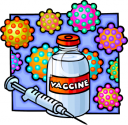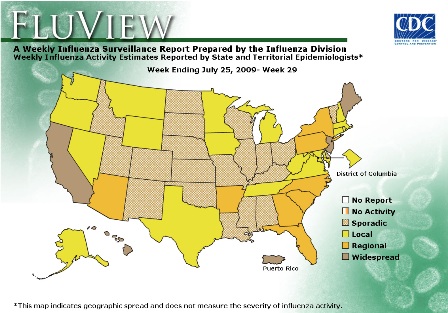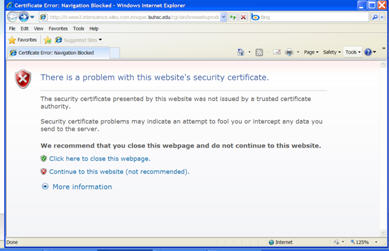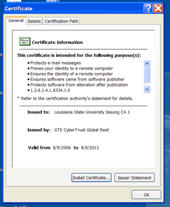Just in time for fall semester, we’ve created a brand spankin’ new guide for you allied health folks. Whether you’re a cardiopulmonary-specialist-to-be or a long time OT faculty member, we’ve got you covered.
Find all the databases for your specialty, plus lists of selected journals, online books, and websites, all in one place:
ALLIED HEALTH RESOURCE GUIDE
http://www.lsuhsc.edu/no/library/resources/guides/AlliedHealth.html
With so many students returning to campus for the Fall semester, we’re seeing a number of issues accessing the wireless network. If the directions that the Library or Nursing School have posted aren’t working out. Try not checking off any of the certificate authorities. When the popup box comes up to accept the security certificate, wait a few moments before clicking OK. It seems like if you click through the boxes too quickly, you end up stuck in a login loop.
If this doesn’t work, we can try to help in the Library or you can hunt down a computer supporter in your school.
Once a year, New Orleans Magazine publishes a list of the Top Doctors in the greater New Orleans area; this list is compiled from a database created by Best Doctors in America. This year there were 564 listings from 66 specialties; the list is created by asking area physicians who they would want to treat an ill family member. Two LSUHSC physicians were featured Kim Edward LeBlanc and Cleveland Moore. Congratulations to everyone on the list!
Allergy & Immunology
Luis R. Espinoza
Cleveland Marvin Moore
Ricardo Sorenson
Cardiovascular Disease
David Lucas Glancy
Critical Care Medicine
Christopher C. Baker
Carol M. Mason
Steve Nelson
Warren Richard Summer
Dermatology
Brian David Lee
Lee T. Nesbitt, Jr.
Endocrinology & Metabolism
Alfonso Vargas
Family Medicine
Kim Edward LeBlanc
Herbert L. Muncie, Jr.
Infectious Disease
Rebecca Adair Clark
Michael Edward Hagensee
David H. Martin
Charles V. Sanders
Internal Medicine
John R. Amoss
David M. Borne
Angela M. McLean
Medical Oncology & Hematology
Lowell Anthony
Neurology
John D. England
Anne L. Foundas
Amparo (Amy) Gutierrez
Piotr Wladyslaw Olejniczak
Austin John Sumner
Nuclear Medicine
Richard J. Campeau, Jr.
Obstetrics & Gynecology
Martha Johnston Brewer
Ralph R. Chesson, Jr.
Felton L. Winfield, Jr.
Orthopaedic Surgery
Andrew G. King
Otolaryngology
Rohan Walvekar
Pain Medicine
Alan David Kaye
Stephen Kishner
Pathology
Randall Douglas Craver
Gary E. Lipscomb
William Proctor Newman III
Pediatric Allergy & Immunology
Cleveland Marvin Moore
Ricardo Sorenson
Pediatric Anesthesiology
Stanley Martin Hall
John Frederick Heaton
Pediatric Cardiology
Robert Joseph Ascuitto
Nancy Tamara Ross-Ascuitto
Aluizio Roberto Stopa
Pediatric Gastroenterology
Raynorda F. Brown
Pediatric Hematology-Oncology
Renee V. Gardner
Tammuella E. Singleton
Maria C. Velez
Lolie Chua Yu
Pediatric Nephrology
V. Matti Vehaskari
Pediatric Orthopaedic Surgery
Andrew G. King
Pediatric Pathology
Randall Douglas Craver
Pediatric Rheumatology
Abraham Gedalia
Pediatric Specialist/Child & Adolescent Psychiatry
Charles C. Coleman
Debra DePrato
Martin J. Drell
Humberton Quintana
Pediatric Specialist/Neonatal-Perinatal Medicine
Brian Barkemeyer
Staci Olister
Duna Penn
Dana Rivera
Pediatric Specialist/Neurology, General
Stephen Russell Deputy
Ann Henderson Tilton
Maria Weimer
Pediatric Specialist/Neurology, Neuromuscular Disease
Ann Henderson Tilton
Pediatric Surgery
Charles Baker Hill, Jr
Pediatric Urology
Joseph Ortenberg
Physical Medicine & Rehabilitation
Stephen Kirshner
Psychiatry
James G. Barbee
Jose Calderon-Abbo
Charles C. Coleman
Erich J. Conrad
Debra Deprato
Howard Joseph Osofsky
Mark Harold Townsend
Pulmonary Medicine
Juzar Ali
Carol M. Mason
Steve Nelson
Judd Ernest Shellito
Warren Richard Summer
David Allen Welsh
Rheumatology
Luis R. Espinoza
Sleep Medicine
Piotr Wladyslaw Olejniczak
Surgery
Christopher C. Baker
J. Philip Boudreaux
John Patrick Hunt III
Surgical Oncology
Eugene A. Woltering
Urology
Sean Collins
Harold Anthony Fuselier, Jr
Jack Christian Winters
Vascular Surgery
Larry Harold Hollier
For a number of years, there have been a several of different certifications for medical laboratory professionals. Depending on whether you were a clinical laboratory scientist or a medical technologist, you may either have a certification of MT or CLS. These certifications were managed by two different credentialing agencies: the American Society for Clinical Pathology Board of Registry (BOR) and the National Credentialing Agency for Laboratory Personnel (NCA).
Complicated? You bet! Having two credentialing agencies created competition and division, and certainly must have been a challenge to both entry level professionals and the labs that hire them to determine which certification was needed, required, and ensured best practices.
However, hope is on the horizon. Recently the ASCP and NCA announced the creation of a single credentialing agency, effective October 23, 2009. The NCA will be dissolved and the new, consolidated credentialing entity will be called the ASCP Board of Certification (BOC). Medical Technologists and Clinical Laboratory Scientists will credentialed as Medical Laboratory Scientists (MLS), and the ?óÔé¼?£ASCP?óÔé¼Ôäó suffix will be attached to all BOC certifications. Medical Laboratory Technicians and Clinical Laboratory Technicians will be unified as Medical Laboratory Technicians (MLT).
For more information on these upcoming changes check out this article from the Dark Daily, a site for clinical pathology news and trends. Detailed information on the unification process can be obtained from this NCA presentation.
Taber’s Cyclopedic Medical Dictionary – 21st Ed. (2009) provides audio pronunciations for 30,000 terms.
Look these up and pronounce them properly!
dacryohemorrhea
pachymenia
saccharomyces cerevisiae
xiphoid
Taber’s is available in Stat!Ref, one of the library’s electronic textbook databases.
EMBASE.com is functioning properly and has some new features.
The best new feature is the suggested EMTREE descriptors at the search box. EMBASE.com uses controlled vocabulary (EMTREE terms and phrases) to focus the literature search to find articles about the topic. Just select the EMTREE term and search. The EMTREE term will be searched as well as the keyword.
It’s not just my imagination. There really are more first year medical students this year. Welcome to campus!
A number of patrons have been receiving a certificate error when attempting to use the Library’s Remote Access system (WAM).
The certificate was renewed by LSU-Baton Rouge but is not propigating properly for some reason. To install the certificate, click on the from the following link. And then choose Open and then Install. Accept any other default settings. *Please note that this certificate only works with Internet Explorer & not Firefox.*
Once installation is complete (takes about 10 seconds), attempt the off-campus link from the Library’s webpages again.
~EDIT~ This issue is now resolved thanks to the efforts of the IT staff.

What vaccines have you had? And what vaccines do you need?
August is National Immunization Awareness Month so take the time of year to look into such questions.
According the Center for Disease Control and Prevention, ?óÔé¼?ôVaccines offer safe and effective protection from infectious diseases. By staying up-to-date on the recommended vaccines, individuals can protect themselves, their families and friends and their communities from serious, life-threatening infections.”
The CDC website offers in-depth resources on immunizations, including an immunization scheduler for bothchildren and adults.
Congratulations to Drs. Janet Leigh and Michael O’Brian who were recently awarded two very prestigious national awards.
Janet Leigh, BDS, DMD, Chair of the Department of Oral Medicine and Radiology at LSU Health Sciences Center New Orleans School of Dentistry, is one of ten Health Policy Fellows selected by the Robert Wood Johnson Foundation?é?« (RWJF) for 2009-10. She is the first dentist to be selected since 1999. The award comes with a grant in the amount of $165,000 for the residential stay, travel, research, conferences, and other leadership development activities.
Michael E. O?óÔé¼ÔäóBrien DDS, JD, Clinical Associate Professor and Director of Predoctoral Studies in the Department of Oral and Maxillofacial Surgery at LSU Health Sciences Center New Orleans School of Dentistry, has been selected as the recipient of the 2009 Daniel M. Laskin Award by the American Association of Oral and Maxillofacial Surgeons. The award recognizes the “Outstanding Predoctoral Educator in OMS” (Oral and Maxillofacial Surgery).
When on-campus many users are experiencing problems accessing videos in both Current Protocols and Springer Protocols. This seems to be an issue with Internet Explorer only. If possible try accessing the same sites in Firefox (neither Chrome or Safari worked for me). We are working with campus IT to have this matter resolved quickly.

CDC’s Advisory Committee on Immunization Practices (ACIP) published the 2009 guidelines for the use of influenza vaccine for the prevention and control of seasonal influenza on July 30th, 2009. These guidelines are for seasonal flu, for which there are vaccines, and not swine flu, though clinical trials are underway for the H1N1 virus.
“Flu season” generally runs October – May. During these months, the CDC collects and publishes weekly influenza surveillance reports, like the one shown above. In fact, you can even get flu updates sent to your phone.
Who needs the seasonal flu vaccine? Health care workers, for one, as well as young children, the aged, pregnant women and people with chronic medical conditions. LSUHSC – NO usually offers flu shots for a small fee during the month of October.
More flu information from the CDC.

The 2010 edition of the Centers for Disease Control and Prevention?óÔé¼Ôäós Yellow Book includes new or expanded sections on medical tourism, traveling safely with chronic diseases and conditions, and expert perspectives on popular travel itineraries worldwide. The updated book, which is a definitive guide for healthy international travel, is now available online.
Our EMBASE.com problem was fixed over the weekend. Please let us know if you encounter any problems: reference@lsuhsc.edu.
~Edit~ Users are reporting that this new version is very glitchy. We are working to resolve the issue. (3:15 pm/Aug. 3, 2009)
EMBASE.com is being transitioned to it’s new version. Unfortunately during that transition (in the Netherlands), our subscription information seems to have been lost. Since Amersterdam has already started their weekend, access will probably not be reinstated until Monday.

 myLSUHSC
myLSUHSC



